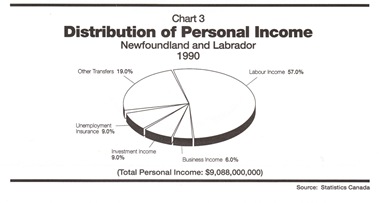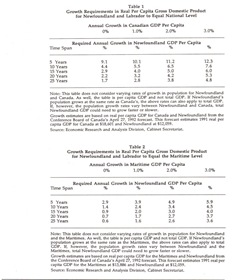The economy of Newfoundland and Labrador is underdeveloped and economic disparities between our province and other provinces in Canada persist. In addition to these long-standing problems, the Province now faces new challenges as the result of global economic change. Thus, in the 1990s, the need to diversify the economy and to improve productivity and competitiveness has become critical.
A Changing Global Economy
The world economy is constantly changing, driven by profound changes in trade patterns, investment flows and technology. More specifically,
- the liberalization of world trade has contributed to rapid growth in export opportunities for manufactured goods and commercial services and, as a result, to increased international competition;
- the emergence of major multinational trading blocs within the world trading system has resulted in an increase in joint ventures, technology sharing and mergers between firms from different countries;
- in order to promote competitiveness within acceptable international trading guidelines, there has been a shift in national and provincial economic policy from direct government subsidies to government support in the areas of business development services, tax incentives, education and training, technological innovation and diffusion, and the provision of economic infrastructure;
- the technological advances made in transportation and communications have reduced the effective distance between producers and consumers. This wider market for our goods and services is also creating opportunities for the development of new products and services, but it means, of course, that we also face more international competition;
- employment opportunities continue to concentrate in urban centres even though traditional impediments to development, such as domestic market size and distance from export markets are playing a lesser role in determining where firms choose to locate;
- the gradual shift from labour-intensive to knowledge-intensive industries, particularly in developed countries where labour costs are higher, has required firms to invest in both new technologies and human resources to improve their competitiveness; and
- environmental considerations are becoming increasingly integrated into the decision-making processes of governments, industries and individuals.
These world-wide economic changes will intensify over the next decade as new technologies and increasing competition force existing industries to restructure and new industries to develop. These changes mean that Newfoundland and Labrador will have to strengthen and build on existing comparative advantages in our resource industries and also target strategic opportunities in new growth industries. If we ignore the realities of a changing global environment, local firms will inevitably find themselves unable to compete at home or abroad.
The Province's Economic Structure and Performance
There are significant differences in economic structure and performance between Newfoundland and Labrador and the rest of Canada, though during the last two decades, our economy has generally mirrored the direction - but not the magnitude - of Canada's economic growth.
 Newfoundland and Labrador's economy is very "open", which means that it is strongly influenced by the level of economic activity elsewhere, largely because of our reliance on resource-based exports. As shown in Chart 1, the goods-producing sector (including the resource industries) accounted for 29% of the Province's gross domestic product (GDP) in 1990, while the services sector accounted for 71% of GDP.
Newfoundland and Labrador's economy is very "open", which means that it is strongly influenced by the level of economic activity elsewhere, largely because of our reliance on resource-based exports. As shown in Chart 1, the goods-producing sector (including the resource industries) accounted for 29% of the Province's gross domestic product (GDP) in 1990, while the services sector accounted for 71% of GDP.
Because Newfoundland and Labrador's goods production is concentrated largely in primary-resource industries, the Province's economy has pronounced seasonality in output and employment, low value-added production and a narrow export base from which to generate new economic wealth. These weaknesses produce persistently high unemployment and low per capita incomes (Chart 2). 
The amount of personal income available is a major determinant of economic activity and of the Province's living standards. The amount of tax revenue which is available to Government for expenditure on areas such as education, health and transportation infrastructure, for example, is also influenced by both the level and distribution of personal income. It is therefore important to understand the relative importance of the components of personal income, specifically labour, business and investment income, unemployment insurance (UI) benefits and other types of transfer income (Chart 3). 
Transfer payments to individuals, such as UI benefits, social assistance, family allowances, pensions and old age security payments, represent the second largest component of personal income in the Province. Some elements of transfer income, such as family allowances and old age security payments, are based on demographic and social factors, while others, such as UI payments, are related to employment (and especially part-year or seasonal employment) and the general level of economic activity in the Province. However, this over-dependence on government transfers is no longer acceptable to most people nor can it be sustained by governments.
The challenge now facing governments, business, labour and other groups is to make sure that this dependence is replaced by productive employment and more appropriate social programs. For the Provincial Government, in particular, this means using its financial resources more efficiently and effectively. 
Chart 4 shows that for the fiscal year 1992-93, total gross capital and current account expenditures are expected to reach $3.5 billion. At present, only 8.7% of that amount, approximately $300 million, is directly targeted for the resource or economic sector. On the other hand, the social sector is expected to consume 65.4% of the budget - about $2.3 billion. Because some traditional social-sector areas, such as education, are directly linked to economic performance, the challenge the Provincial Government faces, now and in the future, is to ensure that economic development considerations influence expenditure decisions.
While there are many opportunities which can contribute to economic growth, they must be pursued within a framework which is realistic and attainable. Too often, when setting goals for economic growth in the Province, achieving the Canadian average has been adopted as a medium-term target. 
This, however, is probably unrealistic: over the medium term (5-10 years) - depending on the Canadian rate of growth -the Provincial GDP would have to grow between 4.4% and 12.3% a year to reach the Canadian average (Table 1).
A more realistic target may be for the Province to attain equality with the Maritime Provinces. The levels of economic growth necessary to reach the Maritime average are shown in Table 2.
The Importance of Productivity and Competitiveness
In the expanding global economy, international competitiveness has become the most important single factor affecting economic growth or decline. Many of the Province's prospects for economic development, therefore, hinge on our willingness, determination and commitment to work together to build a more productive, diversified and efficient economy. One of the greatest challenges is to become more competitive while simultaneously improving the living standards, employment opportunities and real incomes of our people.
Newfoundland and Labrador's productivity performance, in particular, will be a key determinant of our ability to compete, but between 1975 and 1989, the Province experienced one of the lowest productivity growth rates in Canada. As a result, the difference in productivity between this province and the rest of Canada has increased and our economic problems have been compounded. The factors contributing to this disparity include differences in industrial structure, increasing seasonality in the employment of labour and capital, a small, widely dispersed population, lower levels of educational attainment, inadequate investment in capital for technological change, and a lack of cooperation among governments, business and labour. If this trend in productivity is not reversed it will have profound negative implications for our competitiveness, our economic growth and our overall standard of living.
To change this pattern, both old and new businesses in the Province will have to use modern production methods, invest in new technologies, provide adequate training and re-training, and produce higher value-added goods and services. We will all have to be adaptable to a changing work environment and be committed to life-long learning. And governments will have to become more efficient in providing quality public services and ensuring that their policies, programs and actions create an environment that supports real economic growth and diversification.
-srbp-